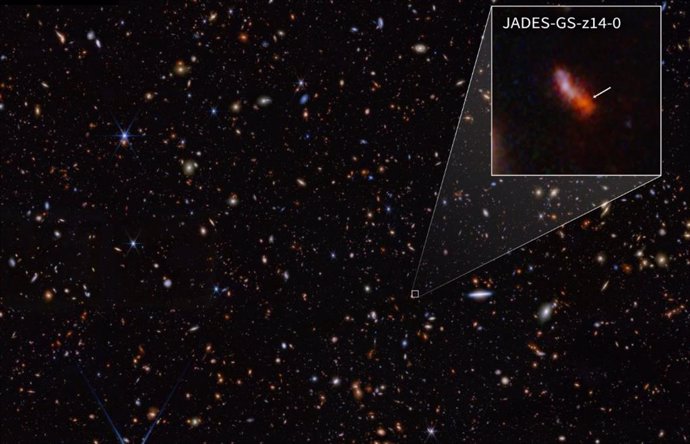JADES-GS-Z14-0 Galaxy, The Farthest Known – NASA, ESA, CSA, STSCI, BRANT ROBERTSON ET AL.
May 30. () –
Observations with the James Webb Space Telescope have shattered the record of the most distant known galaxy, until placing it less than 300 million years after the Big Bang.
The image above, taken in January of this year, was taken by NIRCAM (near-infrared camera) for the James Webb Advanced Deep Extragalactic Survey, or JADES, program. The data was used to determine which galaxies to study further with spectroscopic observations. One of those galaxies, JADES-GS-Z14-0 (shown magnified), was determined at a redshift of 14.32 (+0.08/-0.20), breaking the previous record of 13.2.
This discovery was not just a new distance record. The most important aspect of JADES-GS-z14-0 was that at this distance we know that this galaxy must be intrinsically very luminous. From the images, it is discovered that the source is more than 1,600 light years in diameter, which shows that the light we see comes mainly from young stars and not from emissions close to a growing supermassive black hole.
“So much starlight implies that the galaxy has several hundred million times the mass of the Sun! This raises the question: How can nature create such a large, massive and bright galaxy in less than 300 million years?” ask Stefano Carniani of the Scuola Normale Superiore of Pisa, and Kevin Hainline of the University of Arizona in Tucson, authors of the new research, it’s a statement from NASA.
With the data obtained they affirm that JADES-GS-z14-0 is not like the types of galaxies that theoretical models and computer simulations have predicted that would exist in the early universe.
“Given the observed brightness of the source, we can predict how it might grow over cosmic time, and so far we have not found any suitable analogues of the hundreds of other high-redshift galaxies we have observed in our study. Given the relatively small region of the sky that we searched to find JADES-GS-z14-0, its discovery has profound implications for the expected number of bright galaxies we see in the early universe“, they emphasize.







![[Img #74664]](https://thelatestnews.world/wp-content/uploads/2024/12/James-Watson-The-controversial-genius-behind-the-double-helix-150x150.jpg)






![[Img #74664]](https://thelatestnews.world/wp-content/uploads/2024/12/James-Watson-The-controversial-genius-behind-the-double-helix-300x200.jpg)

Add Comment